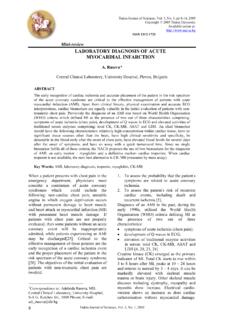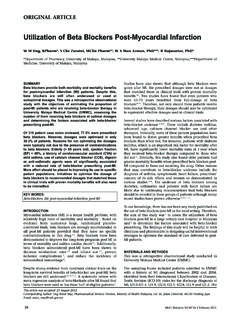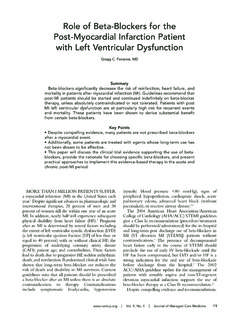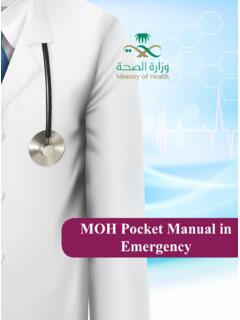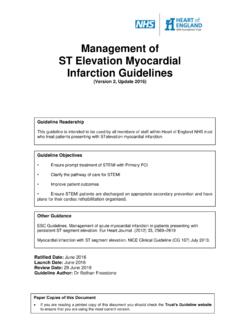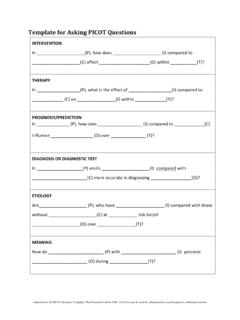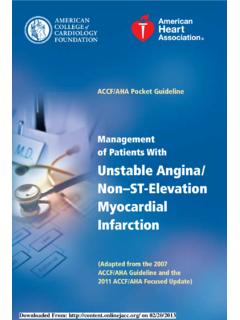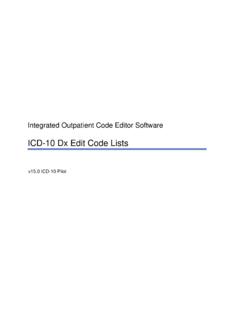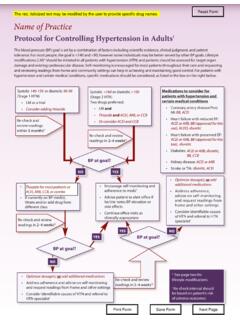Transcription of ANNEX I SUMMARY OF PRODUCT CHARACTERISTICS
1 1 ANNEX ISUMMARY OF PRODUCT OF THEMEDICINAL PRODUCTOfev 100mg soft capsulesOfev 150mg soft AND QUANTITATIVE COMPOSITIONOfev 100 mg soft capsulesOne soft capsule contains 100mg nintedanib (as esilate)Excipient with known effectEach 100 mg soft capsule contains of soya 150 mg soft capsulesOne soft capsule contains 150mg nintedanib (as esilate)Excipient with known effectEach 150 mg softcapsule contains of soya the full list of excipients, see FORMSoft capsule(capsule).Ofev 100 mg soft capsulesOfev 100mg soft capsules are peach-coloured, opaque, oblong soft-gelatin capsules imprinted on one side in black with the Boehringer Ingelheim company symbol and 100 .Ofev 150 mg soft capsulesOfev 150mg soft capsules are brown-coloured, opaque, oblong soft-gelatin capsules imprinted on one side in black with the Boehringer Ingelheim company symbol and 150 . indicationsOfev is indicated in adults for the treatment of idiopathic pulmonary fibrosis (IPF).
2 Ofevis also indicated in adults for the treatment of other chronic fibrosing interstitial lung diseases (ILDs) with a progressive phenotype (seesection ).Ofev is indicated in adults for the treatment of systemic sclerosis associated interstitial lung disease (SSc-ILD). and method of administrationTreatment should be initiated by physicians experienced in the management of diseases for which Ofev is recommended dose is 150mg nintedanibtwice daily administered approximately 12hours 100 mg twice daily dose is onlyrecommended to be used in patients who do not tolerate the 150 mg twice daily a dose is missed, administration should resume at the next scheduled time atthe recommended a dose is missed the patient should not take an additional recommended maximum daily dose of 300mg should not be adjustmentsIn addition to symptomatic treatment if applicable, the management of adverse reactions toOfev (see sections and ) could include dose reduction and temporary interruption until the specific adverse reaction has resolved to levels that allow continuation of therapy.
3 Ofev treatment may be resumed at the full dose (150mg twicedaily) or a reduced dose (100mg twice daily). If a patient does not tolerate 100mg twice daily, treatment with Ofev should be diarrhoea, nausea and/or vomiting persist despite appropriate supportive care (including anti-emetic therapy), dose reduction or treatment interruption may be required. The treatment may be resumed at a reduced dose (100mg twice daily) or at the full dose (150mg twice daily). In case of persisting severe diarrhoea, nausea and/or vomiting despite symptomatic treatment, therapy with Ofev should be discontinued (see section ).In case of interruptions due to aspartate aminotransferase (AST) or alanine aminotransferase (ALT)elevations >3x upper limit of normal (ULN), once transaminases have returned tobaseline values,treatment with Ofev may be reintroduced at a reduced dose (100mg twice daily) which subsequently may be increased to the full dose (150mg twice daily) (seesections and ).
4 Special populationsElderly patients ( 65 years)No overall differences in safety and efficacy were observed for elderly patients. Noa-prioridose adjustment is required on the basis of a patient s age. Patients 75 years may be more likely to require dose reduction to manage adverse effects(see ).Renal impairmentAdjustment of the starting dose in patients with mild to moderate renal impairment is not required. The safety, efficacy, and pharmacokinetics of nintedanib have not been studied in patients with severe renal impairment (<30ml/mincreatinine clearance).Hepatic impairmentIn patients with mild hepatic impairment (Child Pugh A), the recommended dose of Ofevis 100 mg twice daily approximately 12 hours patients with mild hepatic impairment (Child Pugh A), treatment interruption or discontinuation for management of adversereactions should be safetyand efficacyof nintedanib have not been investigated in patients with hepatic impairment classified as Child PughB and C.
5 Treatment of patients with moderate (Child PughB) and severe (Child PughC) hepatic impairment with Ofev is not recommended(see ).Paediatric populationThe safety and efficacy of Ofevin childrenaged 0-18 yearshave not been established. No data are of administration Ofev is for oral use. The capsules should be taken with food, swallowed whole with water, and should not be chewed. The capsule should not be opened or crushed (see section ). Pregnancy (see ) Hypersensitivity to nintedanib, to peanut or soya,or to any of the excipients listed in warnings and precautions for useGastrointestinal disordersDiarrhoeaIn the clinicaltrials (see section ), diarrhoea was the most frequent gastro-intestinal adverse reaction reported(see section ). In most patients, the adverse reaction was of mild to moderate intensityand occurred within the first 3months of cases of diarrhoea leading to dehydration and electrolyte disturbances have been reported in the post-marketing.
6 Patientsshould be treated at first signs with adequate hydration and anti-diarrhoeal medicinal products, loperamide, and may require dose reduction or treatment interruption. Ofevtreatment may be resumed at a reduced dose (100mg twice daily) or at the full dose (150mg twice daily). In case of persisting severediarrhoea despite symptomatic treatment, therapy with Ofev should be and vomitingNausea and vomiting were frequently reported gastrointestinal adverse reactions(see ). In most patients with nausea and vomiting, the event was of mild to moderate intensity. In clinical trials, nausea led to discontinuation of Ofev in up to of patients and vomiting led to discontinuationof Ofev in up to of symptoms persist despite appropriate supportive care(including anti-emetic therapy), dose reduction or treatment interruption may be required. The treatment may be resumed at a reduced dose (100mg twice daily) or at the full dose (150mg twice daily).
7 In case of persisting severe symptomstherapy with Ofev shouldbe function The safety and efficacy of Ofev has not been studied in patients withmoderate (Child PughB) or severe (Child PughC) hepatic impairment. Therefore, treatment with Ofev is not recommended in such patients (see ). Based on increased exposure, the risk for adverse reactions may be increased in patients with mild hepatic impairment (Child Pugh A). Patients with mild hepatic impairment (Child Pugh A) should be treated with a reduced dose of Ofev (see and ).Cases of drug-induced liver injury have been observed with nintedanib treatment, including severe liver injury with fatal outcome. The majority of hepatic events occur within the first three months of treatment. Therefore,hepatic transaminase and bilirubin levels should be investigated before treatmentinitiation and during the first month of treatment with Ofev. Patients should then be monitored at regular intervals during the subsequent twomonths of treatmentand periodically thereafter, at each patient visit or as clinically of liver enzymes (ALT, AST, blood alkaline phosphatase(ALKP), gamma-glutamyl-transferase (GGT), see section ) and bilirubin were reversible upon dose reduction or interruption in the majority of transaminase (AST or ALT) elevations >3x ULN are measured, dose reduction orinterruption of the therapy with Ofev is recommended and the patient should be monitored closely.
8 Once transaminases have returned to baseline values, treatment with Ofevmay be resumed at the full dose (150mg twice daily) or reintroduced at a reduced dose (100mg twice daily) which subsequently may be increased to the full dose (see ).If any liver test elevations are associated with clinical signs or symptoms of liver injury, jaundice, treatment with Ofev should be permanently discontinued. Alternative causes of the liver enzyme elevations should be investigated. Patients with low body weight (< 65 kg), Asian and female patients havea higher risk of elevations of liver exposure increased linearly with patient age, which mayalso result in a higher risk of developing liver enzyme elevations (see section ). Close monitoring is recommended in patients with these risk functionCases of renal impairment/failure, in some cases with fatal outcome, have been reported with nintedanib use (see section ).
9 Patients should be monitored during nintedanib therapy, with particular attention to those patients exhibiting risk factors for renal impairment/failure. In case of renal impairment/failure, therapy adjustment should be considered (see section Dose adjustments).HaemorrhageVascular endothelial growth factor receptor (VEGFR) inhibition might be associated with an increased risk of at known risk for bleeding including patients with inherited predisposition to bleeding or patients receiving a full dose of anticoagulative treatment were not included in theclinical trials. Non-serious and serious bleeding events, some of which were fatal, have been reported in the post-marketing period(including patients with or without anticoagulant therapy or other medicinal productsthat could cause bleeding). Therefore, these patients should only be treated with Ofev if the anticipated benefit outweighs the potential thromboemboliceventsPatients with a recent history of myocardial infarction or stroke were excluded from the the clinical trials, arterial thromboembolic events were infrequently reported( versus placebo for INPULSIS; versus for INBUILD; Ofev versus placebo for SENSCIS).
10 In the INPULSIS trials, a higher percentage of patients experienced myocardial infarctions in the Ofevgroup ( ) compared to the placebo group ( ), while adverse events reflecting ischaemic heart disease were balanced between the Ofev and placebo groups. In the INBUILD trial, myocardial infarction was observed with low frequency: Ofev versus placebo the SENSCIS trial, myocardial infarction was observed with low frequency in the placebo group ( ) and not observed in the Ofev be usedwhen treating patients at higher cardiovascular risk including known coronary artery disease. Treatment interruption should be considered in patients who develop signs or symptoms of acute myocardial and artery dissectionsThe use of VEGF pathway inhibitors in patients with or without hypertension may promote the formation of aneurysms and/or artery dissections. Before initiating Ofev, thisrisk should be carefully considered in patients with risk factors such as hypertension or history of thromboembolismIn the clinicaltrials, no increased risk of venous thromboembolism was observed in nintedanib treated patients.










